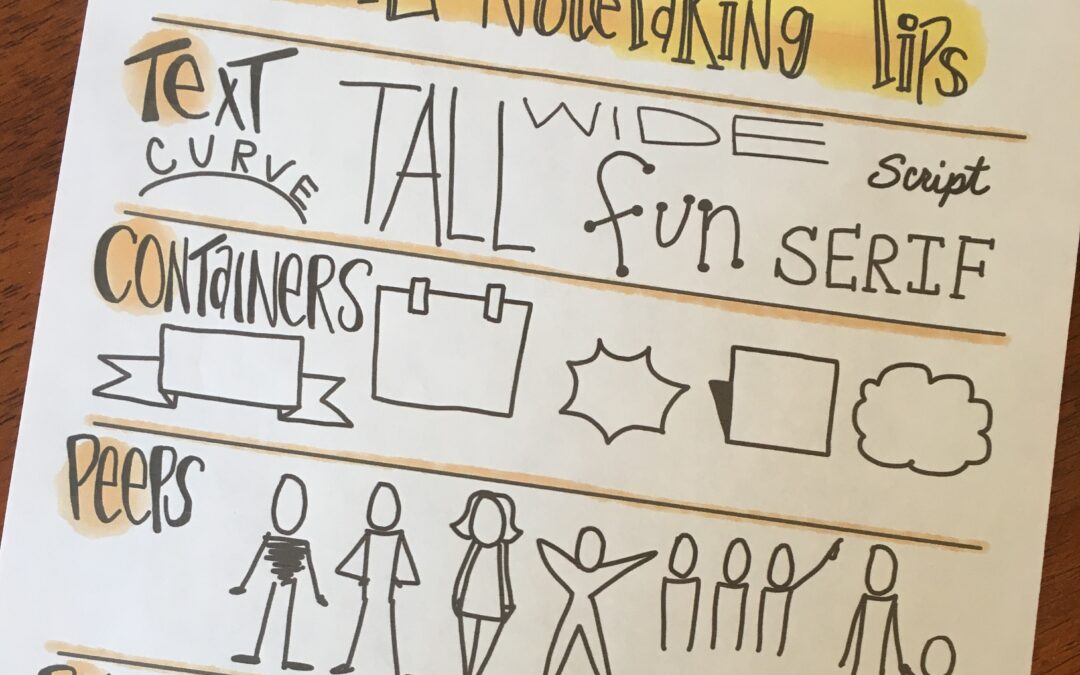
by Lisa | Aug 2, 2024 | Graphic Recording, Resources, Visual Thinking
In the fast-paced world of meetings and brainstorming sessions, keeping everyone on the same page can be a challenge. Traditional note-taking methods often fall short in capturing the creativity of live discussions. Enter visual notetaking – a powerful tool that transforms ideas into engaging visual narratives.
At See In Colors, we believe in the power of visuals to enhance understanding and retention. That’s why we’re excited to offer a free resource to help you bring your ideas to life with our Visual Notetaking Tip Sheet. You’ve seen our team at work graphic recording, well you can use the power of visuals too!
What’s Inside the Tip Sheet?
Our Visual Notetaking Tip Sheet is designed to make it easy for anyone to start drawing out their ideas, regardless of artistic skill level. It covers five essential elements:
1. Text: Learn how to use fonts and styles to make key points stand out.
2. Containers: Discover how to frame information with boxes, clouds, and banners.
3. People: Simple techniques for drawing people to add a personal touch.
4. Bullets: Create clear, organized lists with various bullet styles.
5. Connectors: Use arrows and lines to link concepts and show relationships
Download Your Free Tip Sheet
Ready to take your meeting notes to the next level? Download our Visual Notetaking Tip Sheet for free and start transforming your ideas into visual stories. Click the link below to get started:
Download the Visual Notetaking Tip Sheet
At See In Colors, we’re dedicated to helping you design and facilitate meetings that are not only productive but also visually engaging. Whether you’re brainstorming, planning, or strategizing, our resources are here to support your journey.
Happy drawing!
From the See In Colors Team
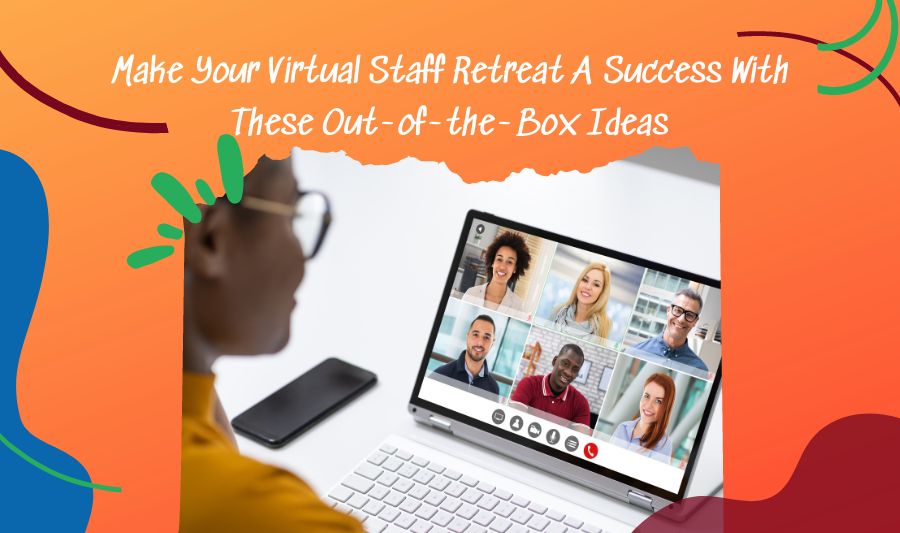
by Lisa | Jul 14, 2022 | Business, Event Planning, Uncategorized, Visual Thinking
After two years of virtual everything, we understand the screen fatigue. People want to retreat from Zoom, not go on a virtual retreat on Zoom. But don’t blame the virtual platforms. Virtual meetings, events, and staff retreats don’t have to play second fiddle to in-person meet-ups. A virtual savvy tech host and a consultation with experts like See in Colors can elevate your virtual staff retreat to one that’s memorable in all the right ways.
Whether you’re hosting a mid-year retreat to rally your team to dig deep through the end of the year, or planning an end-of-year celebration, here are the three components that make for a successful, impactful, and dare we say it…fun virtual staff retreat.
Now we’re talking. Themes are great for unifying an event and getting people off the sidelines and into the action. Develop a comprehensive theme that lends itself well to teams, events, activities, and competitions. A retro theme offers opportunities for costumes, old-school music, and nostalgic TV quizzes. A sports theme brings out people’s natural competitiveness, and can be plenty of fun if you opt for less conventional sports. A theme is great for setting the intention of your time together, while also encouraging participation and good-natured competition. Choose one that’s inclusive and that will resonate with your team.
Too often in day-to-day life, we fail to celebrate the wins – big and small. A virtual staff retreat is the ideal time to cheer on team members who have made a difference, met milestones, or who have done great things within (or outside of) the company. Schedule an award ceremony (formal attire recommended) to cap off your event, as well as daily “awards” to help start each day off on the right note. These can be serious or silly, or a mix of both. By the way – just because the event is virtual doesn’t mean the awards have to be. Arrange to have a small gift or novelty trophy sent to each team member’s address with details of their award.
Sure, staff retreats are a place to come together and do business, but you can’t be all business, all the time! Book entertainers from all walks of life to entertain your team, keep them engaged, or help them tap into their creativity and communication skills. Turns out fun and professional growth go hand in hand! At See in Colors we’ve seen great results including magicians, improv coaches, mindfulness instructors, wellness coaches, and even book authors. These all offer a refreshing perspective that can help your team feel re-energized and excited about how they approach their work.
If a virtual staff retreat is on your to-do list of things to arrange, make sure it’s a good one. Talk to See in Colors about how to ensure your virtual retreat is one everyone will be happy to log on to.
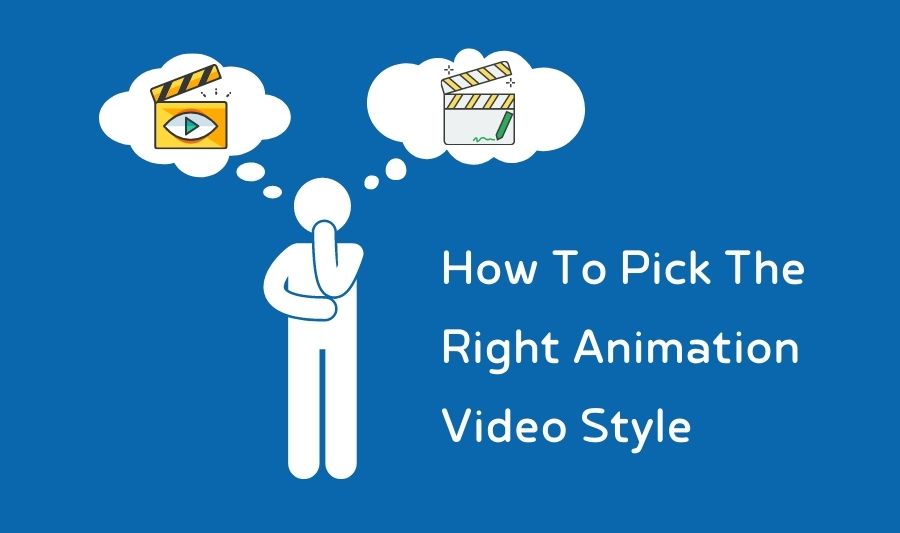
by Lisa | Apr 25, 2022 | Animation Video, Visual Thinking
Hands down, video ranks pretty high when it comes to communication. Adding animation video kicks things up a notch when you need a powerful way to get a point across quickly and succinctly. Animation videos support comprehension and retention – and are increasingly a preferred way for people to consume information. In the corporate world, animation videos in particular are a winning choice for sharing data, educating an audience, or building a brand. Clear, effective, easy to align with your brand style, they have a long shelf life, and are primed for internal or external sharing. But not all animation videos are alike. Each has a different look and purpose, so it pays to be strategic when deciding on your animation video type.
Here are the 3 main animation video styles our clients choose.
2D (two-dimensional) videos feature “flat” animated content. These sorts of videos usually feature characters and voiceover, and are generally used for storytelling purposes. The style and format can vary widely depending on your brand and niche, from loose hand-sketched formats designed to communicate transparency through to the sophisticated, friendly design used by tech start-ups. 2D animation use cases include:
- Corporate storytelling
- Brand or product ads
- Onboarding videos
- Educational videos
Motion graphic animation videos bring ideas, processes, and text to life. This style of video adds motion to things that are usually static, such as charts, graphs, flowcharts or logos – you can think of them like an infographic, but animated. Motion graphics are a great way to communicate complex ideas in a step-by-step, visually pleasing manner. Additionally, motion graphics are effective in situations where the focus is on getting across an idea or process, not a story, and they easily incorporate existing brand assets and styles. Use cases include:
- Explainer videos
- Product or service information
- Presentations
- Corporate awareness
Here’s a little factoid. Animated or “kinetic” typography videos are a subset of motion graphic videos, and feature only moving text combined with a voiceover.
Whiteboard animation videos are a stylized video type designed to look hand-drawn, typically with a white background. These animations are sometimes also known as whiteboard explainer or sketch animation videos. Whiteboard animation videos have a clean and simple look with an “education” vibe to them. They’re popular in the following scenarios:
- Brand education videos
- Selling a product or service
- Communicating complex ideas or data
Whiteboard animation videos are effective and efficient – and can deliver great results.
Not Sure Which Animation Video Type to Choose? Talk to Us.
If your organization is developing an animation video but needs guidance on which style of video to choose, and how to leverage it for best results, talk to the team at See in Colors. We can walk you through the selection process, help you develop a winning script, and even assist with production and voice talent. For more information, contact us.
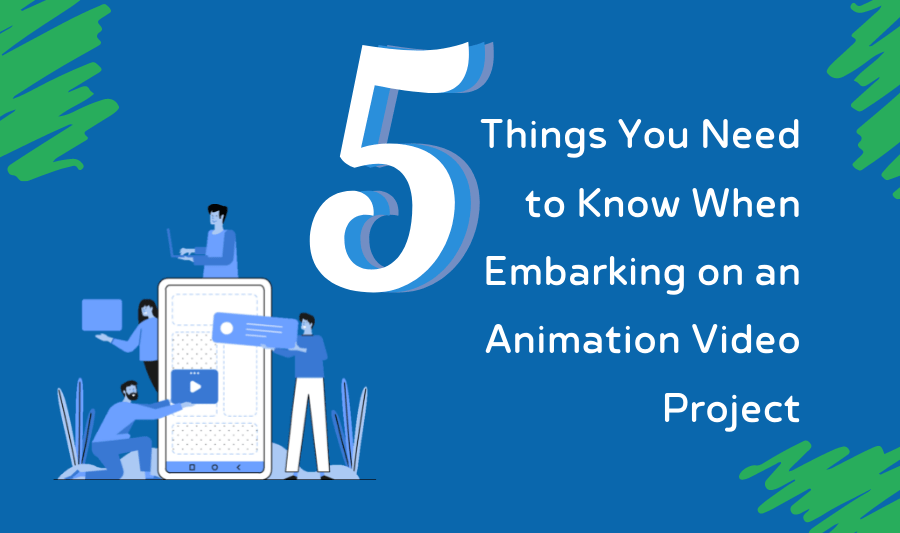
by Lisa | Feb 5, 2022 | Animation Video, Business, Leadership, Technology, Visual Thinking
Animation video is a powerful way to share information, tell stories, and boost learning. Whether your goal is to explain a product or service, or to make information stick for training and development, video elevates your communication by making it possible to break down complex ideas and processes while driving engagement and focus.
But video can also be expensive and time-consuming – with a steep learning curve. Before you embark upon your first video project, here’s what you should know.
Ever cringe your way through a bad movie? The fault probably isn’t with the acting or the special effects. No amount of flashy camerawork or fancy editing can make a great script shine. Perfect your script before you start animation and you’ll save yourself a world of pain (and money). Know who your target audience is, what you’re trying to communicate, and what your call to action (CTA) is. Your CTA creates conversions, so make sure it’s tight, clear and actionable. And don’t forget to keep your script on point: about 90 seconds (220 spoken words) is the sweet spot.
Storyboarding is a way to visually outline the information you’ll be presenting. Use it to create a timeline, identify key scenes and speakers, decide what detail needs to be added to each scene, and figure out your transitions. This is a huge but necessary step – so don’t skip it! Storyboarding will help you hone in on your budget, actors, style, and timeframe. At See In Colors we often consult with clients at this stage to make sure that they’re making powerful use of their visual medium – and that their story is being clearly and effectively communicated.
Music, sound effects, and voiceover delivery are the key things to think about when it comes to your video’s audio. Music sets the tone for your video and fosters certain emotions and experiences in your audience, from the uplifting to the serious to the motivational. Stock music can be affordably sourced through royalty-free databases, but costs add up quickly if you want to license a well-known song. Another thing to think about is who will do your voiceover – someone in-house or a professional? Your choice will influence the mood, style and reception of your video. If you decide to opt for a professional, See In Colors can point you to a great portfolio of proven voiceover artists to convey the tone you desire.
Today, many corporate videos lean heavily on animation. Motion graphics (animated illustrated footage), closed captions or dynamic sketch notes are all powerful options depending on what you’re trying to communicate. Motion graphics are visual aids that are great for breaking down facts and data – such as when explaining stats, processes or procedures. In contrast, whiteboard animation can help get a point across while also telling a story. See In Colors can help you decide which is right for your video, and walk you through stylistic options that will resonate with your branding.
The more work you put in up front, the less reworking you’ll have to do later. If you’re new to video projects, talk to the team at See In Colors to make sure you’re checking every box on the video project to-do list. Making the right strategic decisions early on will reduce time and resources spent editing, rewriting, and redesigning your video.
Ready to press play on a video project? Talk to See In Colors to ensure your project moves forward seamlessly – and with the impact it deserves.

by Lisa | Aug 12, 2021 | Business, Leadership, Productivity, Visual Thinking
Are you looking to improve the employee experience by designing the perfect hybrid workspace? Consider a human-centered design thinking approach when creating the perfect hybrid workspace and you can start by examining these three areas.
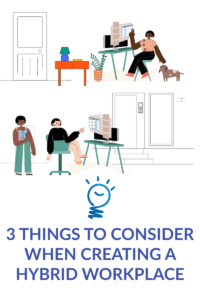
Following the effects of the pandemic, many organizations have had to make a change from the traditional workspace design to adopting a more flexible hybrid design. A hybrid workspace design gives employees flexibility over where they work so that they can effectively work from home and at the office at different periods.
Designing a suitable workspace poses quite a challenge as employees who had been required to work from home for months at a stretch might find coming back to the office an unwanted change.
As a business owner or an HR professional, applying design thinking to the way you design your hybrid workspace post-pandemic can make the difference between retaining quality employees and losing them.
Through human-centered design thinking methods, you can empathize with your employees to create the most favorable and efficient work environment for them.
Some of the things you should consider when creating a hybrid workplace are:
Employee Safety and Wellbeing
While designing your hybrid workspace, one primary thing you have to factor in is the safety of your employees. While employees are at work, you should provide tools and systems that guarantee their safety and compliance with safety measures.
Employee Schedule
To achieve success with the hybrid model, employee roles and responsibilities should be considered during the design process. Some roles require more in-person work than others, and as such, an employee schedule should be designed to accommodate all roles.

Team Meeting and Connectedness
A significant challenge running a hybrid program may pose is the possible disconnect between employees. Good employee relationships have been shown to improve the quality of work in organizations. To foster this, your hybrid workspace should accommodate and encourage communication and connectedness irrespective of the work location.
Are you looking to improve employee experience by designing the perfect hybrid workspace? You can find solutions for your hybrid workplace with our Design Thinking Workshop. You can register here.
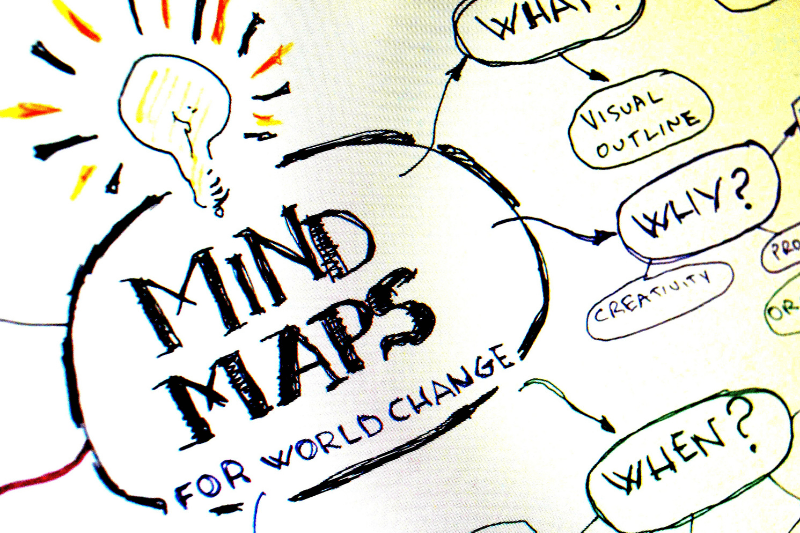
by Lisa | Mar 2, 2021 | Business, Facilitation, Technology, Visual Thinking
Project planning is a crucial phase of your project. You can’t afford to skip it. Visualization techniques can help you get on the right track. Learn if you are using the right tools and techniques to get the desired results.
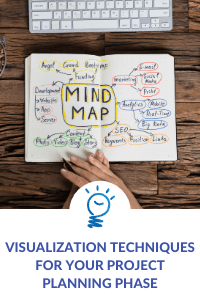
The planning phase is arguably the most crucial stage of a project’s life cycle. At this stage, you determine the logistics, budget, and other important details.
Here you can define and discuss potential problems your project might face at the different stages of execution. Then you can brainstorm with your team and provide possible solutions to these problems.
More importantly, it is during this project planning phase that you need to identify and select the RIGHT problem that your project will solve upon successful execution.
Why?
Identifying and presenting the key problem your project will solve to stakeholders is vital for effective communication and ensuring expectations are met.
So, how can you create an invaluable project management plan and identify the correct problem?
There are several visual planning tools and project plan visualization techniques that can help you execute this crucial part of the project planning phase.
Why Should You Use Visual Planning Tools and Techniques?
Turn a project’s large volume of data into useful and straightforward diagrams that help you brainstorm and communicate the project’s SWOT (strengths, weaknesses, opportunities, threats).
Outline and visualize all stages of your project’s life cycle so you can present a high-level plan to project stakeholders.
Better yet, you can use visual planning tools at all stages of your project execution!
It’s true, visual planning techniques help foster creativity when approaching and solving complex situations or problems. Visual techniques like mind mapping, process maps, or cost breakdown structures are crucial to your project planning.
Types of Visualization Tools for Project and Program Planning
There are many project planning tools and techniques to use for project management, but not all are suitable for the planning phase. Your visual planning phase should be a detailed process where you might use several project planning techniques and tools.
Here are the top visual planning techniques that will help ensure that you identify the key problem, that your project’s stakeholders and team are on the same page and that expectations are clear and met.
1. The Six Thinking Hats:
This can be done remotely or at in-person meetings to explore different viewpoints related to complex situations or problems. Team members will wear different “hats” that represent different thinking perspectives. The six thinking hats are: Creativity, Process, Benefits, Facts, Cautions and Feelings. Use an online whiteboard tool to take notes on each of the participants points of view.
2. Starbursting:
Help meeting participants fully understand the problem that your project is going to solve. Once a team identifies a problem, draw a 5-point star and label each of the 5 points: What?, Where?, When?, How?, and Why? Have meeting participants collaborate and add detailed questions to each of the 5 categories.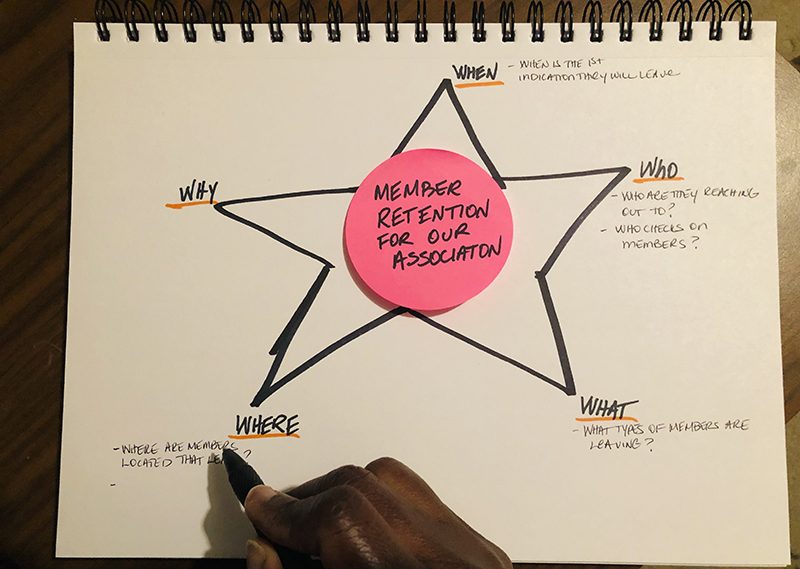
3. The Five Whys:
More specifically used for quality improvement, and to thoroughly analyze a problem, repeatedly ask the question, “Why?”. Using a whiteboard, state the problem. Then list out five boxes below the problem statement, each with the question of why? As you repeatedly answer why, you will eventually reach the root cause of a problem.
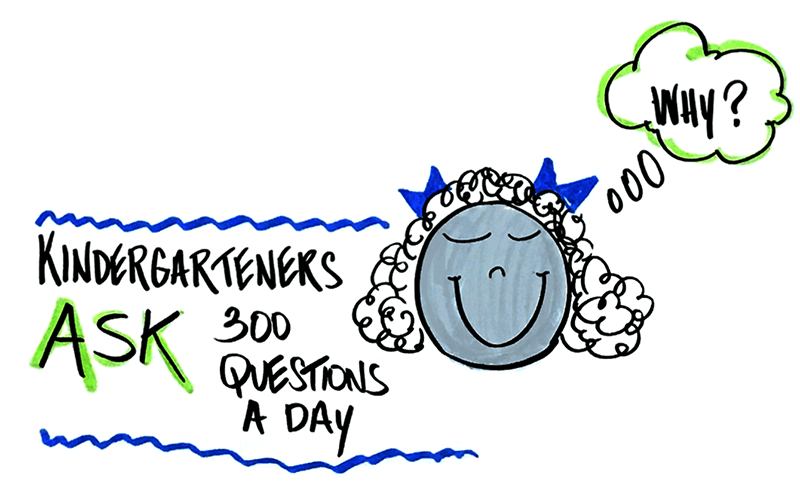
4. Mind Maps:
Mind mapping is a useful way to gather and organize all information about your project. Mind maps are crucial to the information-gathering process. Mind maps can be helpful during brainstorming sessions to generate and gather new ideas. Besides, you don’t have to collect information hierarchically. You can add ideas as they come to mind, and the mind map will help you present the information in an orderly and meaningful way.
Project Management Apps For Visual Project Planning
Project management software helps you collaborate effectively with your team and carry out your visual planning. Most apps are designed to work for remote meetings as well. So, your team members and project stakeholders don’t have to be physically present to brainstorm on your project.
There are various project management applications that help to effectively assign tasks, manage, and track your team’s progress such as Trello, Asana, and TeamGantt. But what about apps for visual project planning?
Think collaborative whiteboard apps, such as Mural, Miro, Zenkit, Google Jamboard and Lucidchart.
Collaborative whiteboard project management apps provide the option to collaborate visually in real-time, and allow meeting participants to add sketches, notes, videos and more to a digital canvas.
Conclusion
Project planning is a crucial phase of your project. You can’t afford to skip it. Visualization techniques can help you get on the right track. But you must be sure you are using the right tools and techniques to get the desired results.
Do you need help facilitating your meeting so that everyone can see the big picture? You can reach out to us here to help you out with visual planning.











